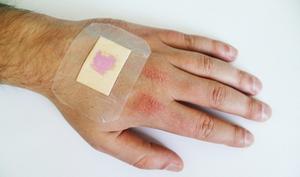Public healthBandages changes color to indicate state of a wound
Medical dressings are effective at protecting the site of an injury, but to examine a wound they must be removed; this can not only be painful for a patient, but it can also allow germs to enter the wound and cause infection; researchers developed dressing materials and plasters that do not need to be removed to check the state of a wound — they indicate pathological changes in the skin by changing from yellow to purple

Bandage color change in the presence of infection // Source: designlaunches.com
While medical dressings are effective at protecting the site of an injury, to examine a wound they must be removed. This can not only be painful for a patient, but it can also allow germs to enter the wound and cause infection.
SifyNews reports that now, scientists at the Fraunhofer Research Institution for Modular Solid State Technologies EMFT in Munich have developed dressing materials and plasters that do not need to be removed to check the state of a wound — they indicate pathological changes in the skin by changing from yellow to purple.
Dr. Sabine Trupp, a scientist at the EMFT, said: “We have developed an indicator dye which reacts to different pH values, and we have integrated it into a dressing and a plaster. Healthy skin and healed wounds usually show a pH value of below five. If this value increases, it indicates complications in the healing of the wound. If the pH value is between 6.5 and 8.5 an infection is frequently present and the indicator color strip turns purple.”
Production of the color-control strip posed a number of challenges for the research scientists as it had to meet several different requirements.
“The dye had to remain chemically stable when bonded to the fibers of the dressing material or the plaster to ensure that it does not get into the wound. At the same time, the indicator had to show a clear change in color and also react sensitively in the right pH range,” said Trupp.
A prototype of the dressing has already been produced and initial tests have proved successful. The next step will be to use the dressing in a hospital environment at the University of Regensburg’s dermatology clinic.
At present Trupp and her team are looking for an industrial partner to produce the dressing commercially.
